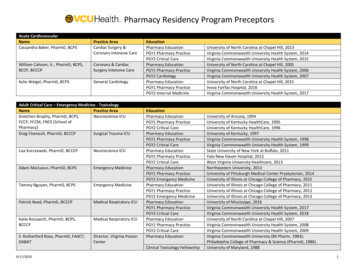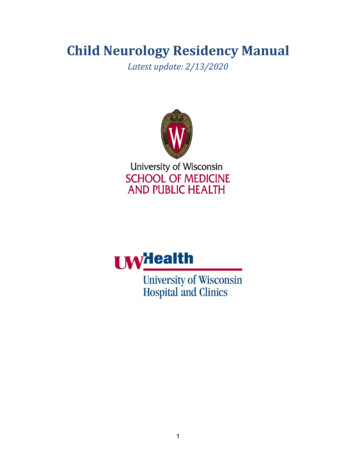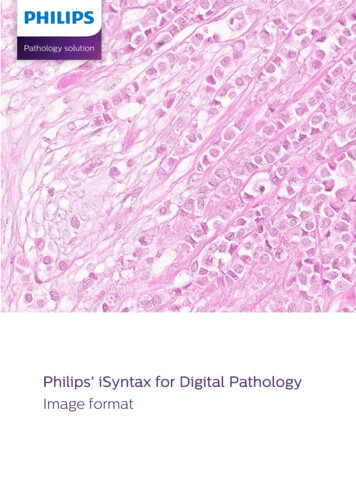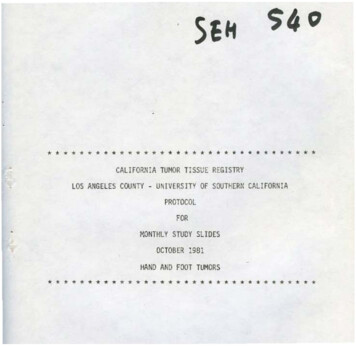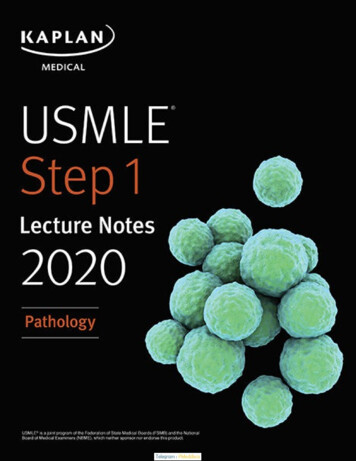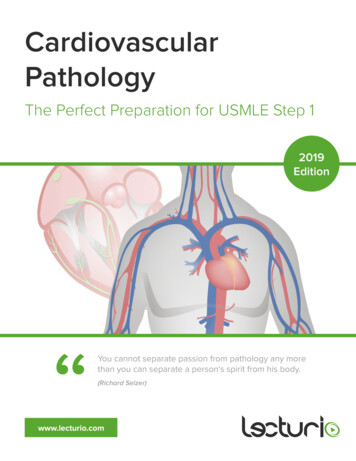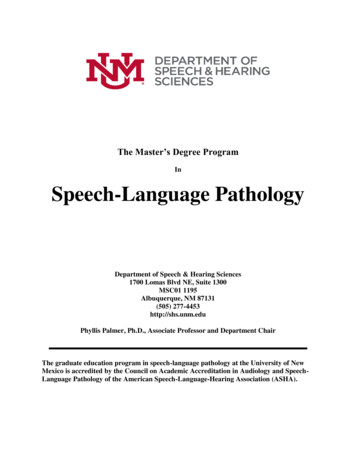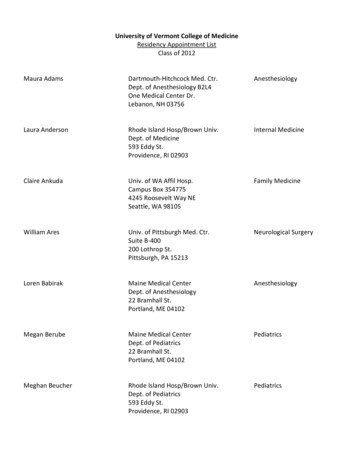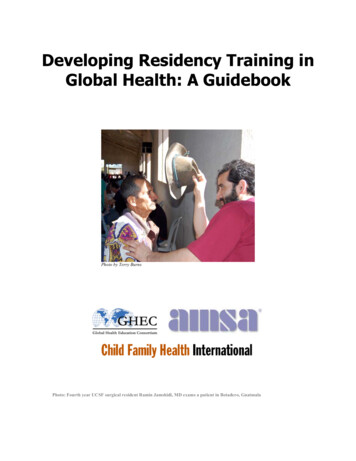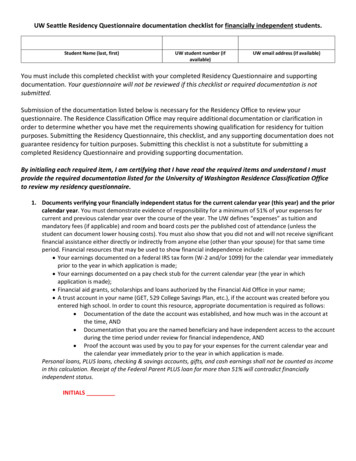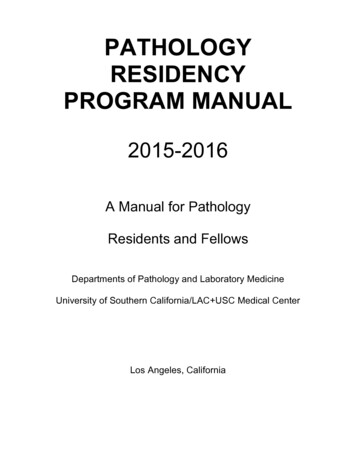
Transcription
PATHOLOGYRESIDENCYPROGRAM MANUAL2015-2016A Manual for PathologyResidents and FellowsDepartments of Pathology and Laboratory MedicineUniversity of Southern California/LAC USC Medical CenterLos Angeles, California
EDITING OF FUTURE RESIDENCY PROGRAM MANUALSA great deal of time and effort went into making this manual as error-free as possible.However, you know that when humans and computers interact, this is not alwayspossible.What to do if there is a need for editing:If you identify typographical errors or inaccurate information or other need for correction: Please photocopy this page from the Manual. Please make a photocopy of the page that requires editing. Staple the page where the error is found to the photocopy of this page. Clearly indicate in red ink what correction(s) is (are) to be made. Make certain that the photocopy clearly shows the page number. Sign your name. Place it in an envelope and send it by Campus Mail to Dr. Naritoku, CT A7A Room119What NOT to do:Do not communicate the correction by: calling e-mailing or by conversationThis request is made to increase the likelihood that edits that you identify will most likelyget done in next year’s manual.Thankyouverymuch!
TABLE OF CONTENTSOverview of Pathology Residency Program ManualIn this manualThis manual contains the following sections.SectionSection 1: Pathology Residency Program PoliciesSection 2: Faculty Supervision of Residents On Call,“Supervisory Resident” in Hematopathology, TransfusionMedicine, Surgical Pathology and Cytology and their“Privileges”Section 3: Educational ActivitiesSection 4A: Year-Specific GoalsSection 4B: Pathology MilestonesSection 5: Program Objectives and Supervision of Residentsin Clinical PathologySection 6: Program Objectives and Supervision of Residentsin Anatomic PathologySection 7: Program Objectives and Supervision of Residentsat USC University HospitalSection 8: Program Objectives, Goarls, and Supervision ofFellows in CytopathologySection 9: Program Objectives, Goals, and Supervision ofFellows in HematopathologySection 10: Program Objectives, Goals, and Supervision ofFellows in NeuropathologySection 11: Program Objectives, Goals, and Supervision ofFellows in Surgical PathologySection 12: FormsSee Page1–12–13–14–15–16–17– 18–19–110 – 111 – 112 – 1
Section 1:Department ofPathology andLaboratoryMedicine ResidencyProgramPolicies andProcedures
Department of Pathology & Laboratory Medicine Residency Program Policies & ProceduresPage 1 - 1SECTION 1: PATHOLOGY RESIDENCY PROGRAM POLICIESOverviewMissionStatement of theLAC USCMedical CenterTo provide fully accessible, affordable and culturally sensitive care one person at atime.Vision of theMedical CenterTo Be Nationally Recognized for Our Superior Patient Care, Medical Education,Clinical Research and Contributions, to Community HealthMissionStatement of theResidencyProgramTo provide residents and fellows with strong and diverse clinical, laboratory andresearch exposure through didactics and service work, preparing them for theirfuture practices in the community practice or academic setting.Vision of theResidencyProgramEquipping tomorrow's pathologist today.Continued on next page
Department of Pathology & Laboratory Medicine Residency Program Policies & ProceduresPage 1 - 2Overview, ContinuedIn this chapterThis chapter contains the following topics.TopicSee PageDefinition: Resident Physician1–6Definition: Attending Physician1–6Definition: Pathology Graduate Medical Education1–6Committee (PGMEC)The ACGME Accreditation System, Milestones and the1–6Clinical Learning Environment Review (CLER) VisitDefinition: Clinical Competency Committee (CCC)1–7Definition: Program Evaluation Committee1–7Faculty Advisors for Residents1–8Policies and Procedures Compliance1–9Competency Based Educational Goals and Objectives1–9Resident Duty Hours in the Learning and Working1–9EnvironmentProfessionalism, Personal Responsibility and Patient Safety,1–9Quality ImprovementTransition of Care1 – 11Alertness, Management/Fatigue Mitigation1 – 11Supervision of Residents1 – 12Levels of Supervision1 – 12Resident Responsibilities/Clinical Responsibilities1 – 14Required Communication with Faculty Regarding Patient1 – 14CareTeam Work1 – 14Resident Duty Hours1 – 15Competency for Routine Procedures1 – 19Conditions Required for Postgraduate Training1 – 21Appointment, Promotion, and Disciplinary Procedures 1 – 21PreambleAmerican and Canadian Medical School Graduates1 – 21International Medical School Graduates1 – 21ACGME Requirements for Resident Transfers1 – 21Postgraduate Training Registration Form1 – 22Resident Selection Process1 – 22California Medical Licensure – ACMG’s1 – 23California Medical Licensure – IMG’s1 – 23California Medical Licensure – Application1 – 24California Medical Licensure – Renewal1 – 24Standards1 – 24Evaluations1 – 25Continued on next page
Department of Pathology & Laboratory Medicine Residency Program Policies & ProceduresPage 1 - 3Overview, ContinuedIn this chapterThis chapter contains the following topics.Topic – ContinuedSee PageOverview and Introduction: The ACGME Outcomes1 – 25ProjectAmerican Board of Pathology Definition1 – 37ACGME-i Definition1 – 38ACGME/ABMS Assessment Toolbox1 – 39ACGME/ABMS Assessment Toolbox Applied to1 – 40PathologySuggested Best Methods for Pathology1 – 41Global Evaluations: Monthly or Rotation-wise1 – 42Evaluations: Semi-Annual1 – 42Evaluations: Summative or Final1 – 42MyEvaluations Internet-based Evaluation –1 – 43Instructions for MyEvaluationsMyEvaluations: Faculty Evaluating1 – 43Residents/FellowsMyEvaluations: Automated Reminders1 – 44MyEvaluations: On The Fly Evaluations1 – 45MyEvaluations: Dyad Relationship1 – 45MyEvaluations: Difference in Faculty and1 – 45Resident WebpageMyEvaluations: Case Logs1 – 45MyEvaluations: Schedule1 – 45MyEvaluations: Fellows1 – 46MyEvaluations: Technical Support1 – 461 – 46Evaluations: 360 EvaluationsEvaluations: Appeals Procedure1 – 46Corrective/Disciplinary Action1 – 46Written Warning1 – 47Written Reprimand1 – 47Advancement and Certification1 – 48Appeals1 – 48Grievance Guidelines for Interns and Residents1 – 49Dismissal1 – 49Time-Keeping and Educational Environment1 – 50Normal Working Hours1 – 50Time Cards1 – 50Morning Conference, Grand Rounds, Other1 – 51ConferencesTeaching Activities1 – 51Electives in Pathology1 – 52Continued on next page
Department of Pathology & Laboratory Medicine Residency Program Policies & ProceduresPage 1 - 4Overview, ContinuedIn this chapterThis chapter contains the following topics.Topic – ContinuedSee PageService Responsibilities During Elective Rotations1 – 52Policy on Elective Rotations1 – 52Research1 – 53Research Elective1 – 54Policies on Time Off1 – 55Vacation Policy1 – 55When to Submit Vacation Requests1 – 55Arrangement for Coverage of Service in Resident’s1 – 56AbsenceUnused Vacation Time1 – 57Family and Medical Leave1 – 57Annual Leave1 – 57Preparation for American Board of Pathology1 – 57ExaminationTime Off for Board Examinations1 – 58Sick Leave1 – 58Buy-Back of Unused Sick Time1 – 58Personal Leave1 – 59Bereavement Leave1 – 59Leaves for Meetings and Conferences1 – 59Funding for Presentations at Meetings and1 – 59ConferencesLeaves of Absence1 – 59Outside Employment (“Moonlighting”)1 – 60ACGME Institutional Requirements Regarding1 – 60Outside EmploymentCounty Policy on Moonlighting1 – 60Department of Pathology and Laboratory Medicine1 – 61Policy on MoonlightingEarly Resignations from Training Programs1 – 63Policies and Procedures for Use of Forms1 – 64Request for Leave Form1 – 64Request for Elective in Pathology Form1 – 64Request for Change of Scheduled Rotation in1 – 64Pathology FormPathology Residency and Fellowship Rotation1 – 65Critique FormPathology Residency and Fellowship Teaching1 – 65Evaluation FormContinued on next page
Department of Pathology & Laboratory Medicine Residency Program Policies & ProceduresPage 1 - 5Overview, ContinuedIn this chapterThis chapter contains the following topics.Topic – ContinuedResident 360 Evaluation FormLibrary and Internet Access, Book FundPathology Resident’s LibraryCounty Internet PolicyBook FundUniform Dress Code for House OfficersIntroductionPurposePolicyGuidelines (Minimum Standards)Examples of Inappropriate AttireComplianceOperating Room Attire (Departmental Policy, notNetwork-Wide)Keck School of Medicine Student Mistreatment ProcedureI. IntroductionII. A Unique Environment: The need for a KeckSchool of Medicine Student MistreatmentProceduresIII. Institutional Standards And DefinitionsPrinciples of CommunityStandards of conduct in the Keck School ofMedicineIV. Reporting ProceduresA. Informal ConsultationB. Formal ReportingV. Reporting Time LineVI. Protection of Complainant and AccusedVII. Mission StatementDisseminationSee Page1 – 651 – 661 – 661 – 661 – 661 – 671 – 671 – 671 – 671 – 671 – 681 – 691 – 691 – 701 – 701 – 711 – 721 – 721 – 721 – 741 – 751 – 751 – 771 – 781 – 791 – 79
Department of Pathology & Laboratory Medicine Residency Program Policies & ProceduresPage 1 - 6Department of Pathology and Laboratory MedicineResidency Program Policy and ProceduresDefinition:ResidentPhysicianA resident physician is defined as a graduate of an accredited medical school in theUnited States or an international student graduate who has met all of thequalifications for training in the United States and the State of California and whois undergoing training towards board certification in Pathology. The PathologyResidency Program is a four-year program with training in Anatomic and ClinicalPathology.Definition:AttendingPhysicianAn attending physician is defined as a credentialed and privileged faculty memberof the Attending Staff Association, LAC USC Medical nCommittee(PGMEC)The Pathology GMEC (PGMEC) provides oversight of the Pathology ResidencyProgram. The Committee is chaired by the Pathology Program Director. Themembership consists of junior and senior Pathology faculty, Pathology co-ChiefResidents (representing PGY4), two peer selected Pathology residents from eachyear of training, PGY1 through PGY3, and the program coordinator.The ACGMEAccreditationSystem,Milestones andthe ClinicalLearningEnvironmentReview (CLER)VisitDeveloped by Thomas J. Nasca, M.D., the Accreditation System of the ACGME isintended to ensure the uniformity of graduate medical education, improve thequality of medical care and patient safety in the United States by allowing theACGME to have an ongoing (semi-annual) review of resident outcomes throughthe Milestones. Diagnostic Radiology, Emergency Medicine, Internal Medicine,Neurological Surgery, Orthopedic Surgery, Pediatrics and Urology and theirsubspecialties have begun the application of the NAS on July 1, 2013. Specialtiesin Phase 2, which includes Pathology, will begin the NAS on July 1, 2014.Pathology Milestones for Anatomic and Clinical Pathology have been developed(27 milestones for APCP4, 26 milestones AP3 and 23 milestones for CP3), ofwhich all residents must achieve by the conclusion of training. The ClinicalCompetency Committee (defined below) meets every six months to assess themilestone level achieved by each resident. Although the milestones are classifiedby the six competencies, they were developed as cognitive, procedural andprofessionalism. Level 1 is a resident on the first day of a given milestone. Level2, 3 and 4 correlate roughly with early, mid and end of training. Level 5 is anaspirational goal that perhaps 5% of residents can achieve, or a practitioner twoCommittee meetings are held at least quarterly or as needed, on the secondTuesday of each month. Issues that residents wish the Committee to considershould be brought to the attention of one of the resident representatives or the coChief Residents. Standing meeting agenda items include the key components ofthe Accreditation Council for Graduate Medical Education (ACGME) CommonProgram Requirements (CPR) and the Review Committee for Pathology (RC)requirements.Continued on next page
Department of Pathology & Laboratory Medicine Residency Program Policies & ProceduresPage 1 - 7ACGMEAccreditationSystem,Milestones andthe ClinicalLearningEnvironmentReview (CLER)Visit, continuedyears out of training. The levels are reported back to the ACGME by the programdirector on a semi-annual basis. The ACGME monitors programs based on theirresidents’ progress in the milestones. While the Accreditation System is believedto reduce the burden of the accreditation process on the program director, itheightens the responsibility of the Sponsoring Institution (SI) whose responsibilityis to ensure the quality of patient care and safety through the clinical learningenvironment. The SI will be visited with a 10 to 14 day notice, approximatelyevery 18 months. The Clinical Learning Environment Review (CLER) visitemphasizes patient safety, quality improvement, transition of care, supervision,duty hour oversight, and professionalism. The CLER visit will focus on five areas:(1) what organizational structures, administrative and clinical processes does the SIhave in place to support GME learning in the above six areas? (2) what is the roleof GME leadership and the faculty to support learning in the above six areas? (3)how engaged are the residents and fellows in using the SI’s current ClinicalLearning Environment infrastructure? (4) how does the SI determine the success ofits efforts to integrate GME into the quality infrastructure? and (5) what areas hasthe SI identified as opportunities for (CCC)The Pathology Clinical Competency Committee (CCC) is composed of boardcertified pathologists, non-physician members (Ph.D.’s) and may include otherssuch as cytotechnologists, pathologists’ assistants, the program coordinator (nonmember). Their function is to review the various evaluation tools of each residentand provide an assessment of each resident for every milestone. The CCCmeetings are held every six months. As the CCC serves an advisory function to theprogram director, the program director does not chair the meeting, but may attendthe meeting. In general, one class is evaluated during one meeting, and followingthe model provided by Vanderbilt University, the evaluation process is doubleblinded in that the residents are not aware of the CCC score prior to their selfevaluation, and the CCC is blinded to the residents’ self-evaluation. Alsofollowing the Vanderbilt model, each milestone is evaluated one at a time for allmembers of a given class. The LAC USC program was an alpha test site for theMilestones along with Massachusetts General Hospital, Vanderbilt University andThe Methodist Hospital.For more information on the NAS, Pathology Milestones, the CLER visit andCCC, refer to the article “The Pathology Milestones and the Next AccreditationSystem” in Archives of Pathology and Laboratory Medicine, tteeACGME Common Program Requirement (V.C.) requires that the residencyprogram is evaluated annually:V.C.1. The program must document formal, systematic evaluation of thecurriculum at least annually. The program must monitor and track each of thefollowing areas:V.C.1.a) resident performance;V.C.1.b) faculty development;Continued on next page
Department of Pathology & Laboratory Medicine Residency Program Policies & ntinuedPage 1 - 8V.C.1.c) graduate performance, including performance of programgraduates on the certification examination; and,V.C.1.d) program quality. Specifically:V.C.1.d).(1) Residents and faculty must have the opportunity toevaluate the program confidentially and in writing at leastannually, andV.C.1.d).(2) The program must use the results of residents’assessments of the program together with other programevaluation results to improve the program.V.C.2. If deficiencies are found, the program should prepare a written plan ofaction to document initiatives to improve performance in the areas listed in sectionV.C.1. The action plan should be reviewed and approved by the teaching facultyand documented in meeting minutes.The Program Evaluation Committee (PEC) is the Committee responsible forperforming the Annual Program Evaluation (APE). Following the aboveguidelines, the PEC performs the APE around March or April every year, andutilizes information from residents evaluation of the program and faculty teachingthrough MyEvaluations, the resident ACGME online survey, the Fall Institutionalresident/fellow online survey, the annual Pathology Resident Retreat, ASCP RISEresults (frequently missed questions), American Board of Pathology score cards,anonymous faculty evaluations of the program and faculty development (newpublications, presentations and grants). The composition of the membership of thePEC is the same members of the Pathology GMEC. The report generated by thePEC serves as the minutes, which document any corrective action plan, and iscalled the Annual Program Evaluation (APE).Faculty Advisorsfor ResidentsA Faculty Advisor is appointed to each resident to provide advice andcounsel about matters pertaining to the Pathology Residency Program.These appointments are not permanent, and as the resident’s career goalschange, the resident may choose to select a different Faculty Advisor.Residents should consult their advisors regarding choice of electives orother matters as may be needed or appropriate. Also, advice about careerand job opportunities is also discussed with the Faculty Advisor.Continued on next page
Department of Pathology & Laboratory Medicine Residency Program Policies & ProceduresPolicies andProceduresCompliancePage 1 - 9Policy is in accordance with:Manual for Graduate Medical Education Programs of Los AngelesCounty University of Southern California Medical Center, the Keck School ofMedicine of the University of Southern CaliforniaAccreditation Council for Graduate Medical Education (ACGME) Institutional andCommon Program Requirements (CPR)ACGME Residency Review Committee (RRC) Pathology Program Requirements.CompetencyBasedEducationalGoals andObjectivesThe competency based educational goals and objectives by year of training aredefined in compliance with ACGME / RRC requirements for the PathologyResidency education program. The resident is required to achieve competency inpatient care, medical knowledge, practice-based learning and improvement,interpersonal and communication skills, professionalism and systems basedpractice. Goals and objectives are defined for the overall program and eachrotation.Resident DutyHours in theLearning andWorkingEnvironmentTo comply with the USC/LAC USC Institutional and ACGME 2011 Standards,which state: “Residency is an essential dimension of the transformation of themedical student to the independent practitioner along the continuum of sibilityand PatientSafety, QualityImprovementThe Program conducts annual educational conference on ‘Fitness for duty:Alertness Management and Fatigue Mitigation’. ACGME CPR VI.A.1 page 12.The Program will promote resident well-being, patient safety, and QualityImprovement. ACGME CPR VI.A.2 page 12.The Program ensures that residents are formally educated in Quality Improvementprinciples in an integrated curricular approach. ACGME CPR VI.A.3. Residentsparticipate in interdisciplinary clinical quality improvement and patient safetyprograms. Evidence of such activities is documented in bimonthly programGMEC minutes that summarize recent and current activities. Selected residentprojects are presented at the Pathology Grand Rounds.Continued on next page
Department of Pathology & Laboratory Medicine Residency Program Policies & d PatientSafety, QualityImprovement,continuedPage 1 - 10Expectations of each resident includes:1. Participation in a quality improvement project
Resident 360 Evaluation Form 1 – 65 Library and Internet Access, Book Fund 1 – 66 Pathology Resident’s Library 1 – 66 . quality of medical care and patient safety in the United States by allowing the ACGME to have an
